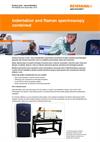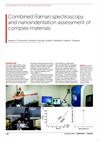奈米壓痕
現場將壓痕的機械特性量測與拉曼的全方位化學分析直接進行關聯處理。
拉曼/奈米壓痕
結合 inVia 功能與奈米壓痕量測,並且直接將機械及磨潤特性與諸如多形性、相位及應力/應變等化學資訊進行關聯處理。
單一組合型系統
inVia 可使用我們提供的光纖技術耦接至各種奈米壓痕系統,例如 Hysitron 提供的 TI 950 TriboIndenter®。此類配對產生組合式儀器,可大幅增強特性分析能力。
為了使效率達到最大,您可以藉由壓痕與拉曼光譜分析樣品上的同一個位置,無需在不同的儀器之間轉移樣品與改變樣本方向。還可以獨立及同時使用 inVia 與奈米壓痕機,完全不會影響個別效能。
從樣品收集高品質關聯資料
- 奈米級壓痕、刮痕與磨損分析
- 測定局部、機械與磨潤特性
- 用於表面形貌成像的現場 SPM
- 用於化學與結構特性的拉曼光譜
更深入瞭解奈米級與微米級的機械特性與變形行為。
下載:奈米壓痕
-
 Application note: Indentation and Raman spectroscopy combined [en]
Application note: Indentation and Raman spectroscopy combined [en]
Combine the power of inVia™ with nanoindentation measurements and directly correlate mechanical and tribological properties with chemical information such as crystallinity, polymorphism, phase and stress/strain. Raman spectroscopy is a powerful technique commonly used to study the composition, uniformity, strain, stress and disorder of materials. However, it does not directly characterise physical, mechanical and tribological properties. Renishaw and Hysitron have combined an inVia confocal Raman microscope with a TI 950 TriboIndenter, producing a system with the capability to directly correlate mechanical property measurements with comprehensive chemical analyses, in situ.
-
 News release: Combined Raman spectroscopy and nanoindentation assessment of complex materials [en]
News release: Combined Raman spectroscopy and nanoindentation assessment of complex materials [en]
An article in the July/August 2016 issue of Microscopy and Analysis presents a new system that physically couples a Raman spectroscopy system with a nanoindenter on a shared stage that uniquely enables combined assessment of materials with submicrometre spatial resolution at single sites or spanning millimetre-sized regions.
深入瞭解
最新奈米壓痕消息
美國科羅拉多大學波德分校結合拉曼光譜與奈米壓痕
科羅拉多大學波德分校的生物力學與仿生學研究試驗所使用 Renishaw inVia™ 共軛焦拉曼顯微鏡進行生物組織與生物材料的特性分析。該系統已連結美國明尼亞波利斯 Hysitron Inc 的奈米壓痕機系統,提供樣品上的化學與機械組合資訊。

